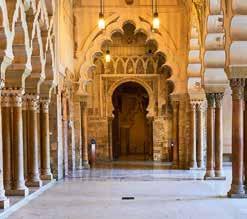
2 minute read
ISLAM (V). THE ARTISTIC LEGACY
9.1 Architecture and decoration
The Islamic religion generally forbids* the representation of human or animal figures. This is why the main artistic features were architecture and applied art, which included a variety of small objects made from ceramic, wood, ivory, bronze and leather.
The exterior decoration of the buildings was very modest, but the interior was covered with marble, tiling and wood and plaster panels. The main artistic motifs were stylised plants and patterns called arabesque; interlaced geometric figures which formed stars or polygons, known as geometric patterns; and inscriptions with verses of the Koran, or calligraphy.

9.2 The mosque and other buildings
The mosque is the most important Muslim building. Its structure is based on Muhammad’s house, in Medina, and is made up of two parts: the courtyard and the prayer hall.
• The courtyard is an open space, surrounded by a portico. There is a fountain for the ablutions where the congregation performs their ritual cleansing before prayer, and a tower, or minaret, from which the muezzin calls the congregation to prayer.
• The prayer hall is a covered section, divided by pillars and arches. One of its walls, the qibla, faces Mecca, and it is identified by a mihrab, or niche, in its centre, where the Koran is kept.
Some of the most prominent mosques are those found in Damascus, Kairouan, Samarra, Jerusalem and Córdoba. Some mosques have a central floor, such as the one found in Jerusalem, built in the 7th century. The palaces were where the caliphs lived. There was a public area, where the throne hall was located, and a private section, where the living quarters, the baths and the harem were located. They all had gardens and fountains.
Other buildings constructed by the Muslims were citadels, or fortresses; mausoleums, or burial sites, and madrasas, educational institutions for religious or secular studies.
Skill progress
Analysing styles I see, I think, I ask myself
1 Identify the typical Muslim architectural elements in the buildings in the pictures.

Go to analysing works of art (I). Architecture
Architecture made use of basic materials such as brick, plaster and wood.
Architects used pillars and columns to support the arches which were horseshoeshaped, pointed or lobed. The roofs were flat or domed.
Focus on English forbid: to not allow.
2 What were the main types of Muslim buildings? What function did each of them have?
3 Describe the type of decoration shown in the picture. What materials were usually used to make it?
The mosque. Elements and areas
1. The mihrab is a niche that identifies the qibla or the wall that faces Mecca, marking the direction that Muslims must face during prayer. The Koran is often placed on a stand in this niche.
2. The minbar is a pulpit from where the imam delivers the sermons on Fridays. It consists of a staircase and a platform. According to tradition, this platform is reserved for God, which is why the imam stays on the step below it.
3. Interior of the prayer hall with galleries divided by pillars and arches.
Understanding art
4 Answer these questions about mosques: a) What inspired their design? b) Find the following elements in the courtyard and in the prayer hall and explain their use: the fountain, the qibla, the mihrab, the minaret.
5 What contrasts are there between the exterior and the interior of Muslim buildings?
6 Why are there so few examples of sculptures and paintings in Muslim art?










